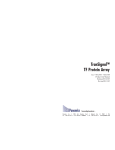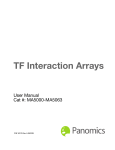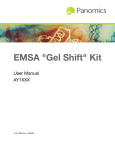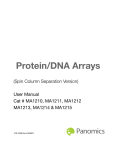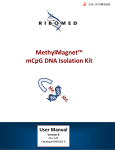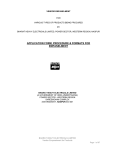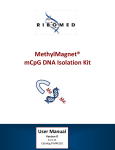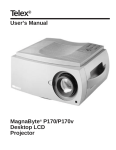Download TranSignalTM Promoter Methylation Array
Transcript
TranSignalTM Promoter Methylation Array Cat. # MA7010 Product User Manual Released 05/25/05 Transcending boundaries ... Panomics, Inc. • 2003 East Bayshore Road • Redwood City, CA 94063 • USA Tel.: 650.216.9736 or 877.726.6642 (PANOMIC) • Fax: 650.216.9790 • www.panomics.com 2 TranSignalTM Promoter Methylation Arrays Contents 1. INTRODUCTION ..................................................................................................3 2. MATERIALS PROVIDED ........................................................................................6 3. ADDITONAL MATERIALS REQUIRED .....................................................................6 4. PREPARING GENOMIC DNA FROM CELLS OR TISSUES ..........................................7 5. FRAGMENTATION OF GENOMIC DNA ...................................................................7 6. LIGATION OF PCR ADAPTORS TO DNA FRAGMENTS ..............................................8 7. ISOLATION OF METHYLATED DNA FRAGMENTS.....................................................8 8. BIOTINYLATION OF METHYLATED DNA FRAGMENTS .......................................... 10 9. HYBRIDIZATION.............................................................................................. 10 10. DETECTION ................................................................................................... 11 11.RESULTS & ANALYSIS ..................................................................................... 12 12.TROUBLESHOOTING GUIDES .......................................................................... 13 APPENDIX A: Recipes & instructions for diluting stock solutions .............................. 14 APPENDIX B: Schematic diagram of the TranSignal Promoter Methylation Array I .. 15 APPENDIX C: Schematic diagram of the TranSignal Promoter Methylation Array II .. 16 APPENDIX D: Stripping procedure for TranSignal Arrays ......................................... 17 APPENDIX E: TranSignal Protein/DNA Array Grid .................................................. 18 Trademarks, Patents, and Limited Warranty PanomicsTM and TranSignalTM are trademarks of Panomics, Inc. FluorChemTM is a registered trademark of Alpha Innotech Corporations. HyperfilmTM is a trademark of Amersham Pharmacia Corporation This product is intended for research purposes only. Panomics products may not be resold, modified for resale, or used to manufacture commercial products without written approval by Panomics, Inc. Panomics, Inc. warrants that the performance of this kit meets Panomics’ performance specifications from the time of shipment until the expiration date, if stored under the recommended conditions. Panomics disclaims all other warranties, either express or implied, including without limitation and implied merchantability or fitness for a particular purpose. Under no circumstances shall Panomics be liable for any damages arising out of the use of the materials. 2001–2005 C Panomics, Inc. All rights reserved. (PD UM012505) For Technical Support, call 1.877.726.6642 (PANOMIC) or visit our Web site at www.panomics.com. TranSignalTM Promoter Methylation Arrays 1. INTRODUCTION DNA methylation is a commonly occurring modification of human DNA. This modification involves the addition of a methyl group to cytosine residues at CpG dinucleotides, a reaction that is catalyzed by DNA methyltransferase (DNMT) enzymes. CpG dinucleotides are gathered in clusters called CpG islands, which are unequally distributed across the human genome. There are approximately 30,000 CpG islands in the genome and 50-60% of these are within the promoter region of genes. CpG islands are primarily unmethylated in normal tissues, and the aberrant methylation of CpG islands is clearly related with diseases, such as cancer. Research shows that MeCP2 is a member of a family of proteins that selectively recognizes methylated CpGs. The binding of these proteins to DNA leads to an altered chromatin structure, which subsequently prevents the binding of transcription machinery, and thus precludes gene expression. The abnormal methylation causes transcriptional repression of numerous genes, leading to tumor growth and development. Studies of DNA methylation in cancer have uncovered new potential targets for the diagnosis, prognosis and ultimately the treatment of human cancer. There has been a delay in the appreciation of methylation as an important epigenetic event in cancer progression. This has been due to the difficulties associated with the analysis of DNA methylation, as standard molecular biology techniques do not preserve methylation of the genomic DNA. The first conventional method employed for the analysis of DNA methylation used methylation sensitive restriction enzymes, coupled with Southern blot analysis of DNA fragments. This approach is reliable, but time consuming, and requires a substantial amount of high quality genomic DNA. Recently, another method has been adopted to study promoter methylation. This uses sodium bisulphate conversion of methylated bases in conjunction with PCR amplification and sequencing of the PCR product. This method is very tedious and inconsistent and all of the conventional methods are time consuming, allowing the analysis of one promoter at a time. Panomics has developed a new technology for the high throughput analysis of promoter methylation, which simultaneously profiles the methylation status of 100 different promoter regions, from one sample. For Technical Support, call 1.877.726.6642 (PANOMIC) or visit our Web site at www.panomics.com. 3 4 TranSignalTM Promoter Methylation Arrays Principle of TranSignal™ Technology TranSignal Arrays use a proprietary, patent-pending technology developed by Panomics for the high-throughput analysis of promoter methylation. The TranSignal procedure is simple and straightforward (Figure 1). Three basic steps are involved: (1) Genomic DNA is digested with a restriction enzyme to isolate DNA with CpG islands. The digests are purified and adapted with linkers. (2). The adapted DNA is incubated with a methylation binding protein, which forms a protein/DNA complex. These complexes are separated and methylated DNA is isolated. (3) The methylated DNA is labeled with biotin-dCTP via PCR and these probes are hybridized to the methylation array For Technical Support, call 1.877.726.6642 (PANOMIC) or visit our Web site at www.panomics.com. TranSignalTM Promoter Methylation Arrays Figure 1: Schematic flow chart of the TranSignalTM Promoter Methylation Array procedure. For Technical Support, call 1.877.726.6642 (PANOMIC) or visit our Web site at www.panomics.com. 5 6 TranSignalTM Promoter Methylation Arrays 2. MATERIALS PROVIDED Box 1: Array Membranes & Hybridization Reagents (4 oC) • TranSignalTM Promoter Methylation Array (3 each) • DNA Purification Columns (6 Columns) • DNA Purification Column Collections Tubes (6 Tubes) • Separation Column (3 each) • 1X Column Incubation Buffer (2 ml) • 1X Column Wash Buffer (10 ml) • 1X Column Elution Buffer (200 µl) • Hybridization Buffer (15 ml) • 20% SDS (15 ml) • Streptavidin-HRP conjugate (60 µl) • Solution I (600 µl) • Solution II (600 µl) • Solution III (5 ml) • PE Buffer (5 ml) • PB Buffer (650 µl) Box 2: Reaction Kit (-20 oC) • Distilled H2O (RNase, DNase free; 500 µl) • 2X Blocking Buffer (30 ml) • 1X Detection Buffer (60 ml) • 10X ligase Binding Bufer (10 µl) • Ligase (6 µl) • 5X Binding Bufer (25 µl) • MBP (6 µl) • Linker (15 µl) • Biotin dCTP labeling Mix (15 µl) • 2X PCR Buffer (80 µl) • 20X SSC (32 ml) • 4X Wash Buffer (45 ml) 3. ADDITIONAL MATERIALS REQUIRED 3.1 Reagents and Solutions • Genomic DNA Extraction kit (e.g., Panomics Genomic DNA Extraction Kit, Cat. # AY2005) • MseI Restriction Enzyme • Hybridization Wash I (2X SSC/0.5% SDS)* • Hybridization Wash II (0.1X SSC/0.5% SDS)* For Technical Support, call 1.877.726.6642 (PANOMIC) or visit our Web site at www.panomics.com. TranSignalTM Promoter Methylation Arrays • Deionized H2O * See Appendix A for recipes. 3.2 Materials and Equipment • • • • 0.5-ml and 1.5-ml microfuge tubes Pipetman and tips Microcentrifuge Hybridization oven and bottles (Stratagene, Cat.# 401030) Note: skirted centrifuge tubes with screw caps may be used in place of the hybridization bottles (VWR, Cat. # 21008-480). Hybridization bottle dimensions: 150 mm x 35-mm diameter tubes. • Plastic containers (~4.5" x 3.5"; equivalent to the size of a container for 200-µl pipet tips) • Shaker • Plastic wrap, plastic sheet protectors, or overhead transparency (used for detection, see Section 7.6) • Hyperfilm ECL (Amersham, Cat.# RPN3114K) OR • Chemiluminescence imaging system (e.g., FluorChemTM from Alpha Innotech Corp.) 4. PREPARING GENOMIC DNA FROM CELLS OR TISSUES Genomic DNA can be prepared using a commercially available kit, such as Panomics’ Genomic DNA Extraction Kit (Cat. # AY2005). For best results, your DNA should have a concentration of 100 - 500 ng/ml . 5. FRAGMENTATION OF GENOMIC DNA In this section, you will digest the genomic DNA with MseI restriction enzyme, to produce small fragments of DNA (<200 bp) that retain the CpG islands. 5.1 Set up the following restriction digest: Genomic DNA (200 ng/µl) 10X NE Buffer 2 10 µl 2 µl For Technical Support, call 1.877.726.6642 (PANOMIC) or visit our Web site at www.panomics.com. 7 8 TranSignalTM Promoter Methylation Arrays MseI (New England) dH20 1 µl 7 µl Total Volume 20 µl o 5.2 Mix well by pipetting and incubate at 37 C for 2 hours. 5.3 Add 100 µl PB Buffer to the digest reaction and transfer 120 µl of this reaction mix to the DNA purification column Note Ensure that the yellow, DNA purifiaction columns are used for this step. 5.4 Bind the DNA to the column, centrifuge at 10,000g, for 30 - 60 s. 5.5 Discard flow through. 5.6 Add 750 µl PE Buffer and centrifuge at 10,000g, for 30 - 60 s. Note Ensure that the correct wash buffer is used for this step. 5.7 Discard the flow-through and centrifuge the column at maximum speed, for 1 min. 5.8 Elute the DNA by adding 20 µl dH20 to the center of the column membrane and let the column stand for 1 min. Then centrifuge the column at maximum speed, for 1 min. 6. LIGATION OF PCR ADAPTORS TO DNA FRAGMENTS In this section, you will add the adaptors for future PCR steps to the restricted ends of the DNA fragments. 6.1 Add the following components to a 0.5 ml microfuge tube. Digested DNA (from step 5.8) Linker 10X ligase binding buffer dH20 10 µl 2 µl 2 µl 4 µl Total Volume 18 µl 6.2 Heat the samples at 50°C for 3 min. 6.3 Lower the temperature to 25°C . 6.4 Add 2 µl of ligase. For Technical Support, call 1.877.726.6642 (PANOMIC) or visit our Web site at www.panomics.com. TranSignalTM Promoter Methylation Arrays 6.5 Mix components by pipetting and incubate at room temperature, for 30 min. 6.6 Repeat steps 5.3 - 5.8 7. ISOLATION OF METHYLATED DNA FRAGMENTS In this section you will isolate the methylated DNA fragments, from the non methylated fragments. All centrifuge steps should be carried out on a regular benchtop centrifuge, at 7,000 rpm at 4°C, unless otherwise stated 7.1 Add the following components to a 0.5 ml microfuge tube: MBP Linker DNA (from step 6.8) 5X Binding Buffer 2 µl 14 µl 4 µl Total Volume 20 µl 7.2 Mix components by pipetting and incubate at 15°C, for 30 min. 7.3 Meanwhile, wash the Protein Spin Column by adding 500µl chilled 1X Column Incubation Buffer and centrifuging at 7,000 rpm for 30 sec at 4°C. Note Ensure the pink, Protein purification columns are used for this step. 7.4 Add 20µl 1X Column Incubation Buffer to the MBP-DNA, from step 7.1. Transfer all of this mix into the center of the Protein Spin Column. 7.5 Incubate the Spin Column on ice for 30 min. 7.6 Centrifuge column at 7,000rpm for 30 sec at 4°C and discard the flow through. 7.7 Place the Spin Column in a new Spin Column Collection Tube (provided). 7.8 Add 600µl 1X Column Wash Buffer to the Spin Column and incubate for 10 min, on ice. 7.9 Centrifuge column at 7,000rpm for 30 sec at 4°C and discard the flow through. 7.10 Wash the column by adding 600µl 1X Column Wash Buffer to the Spin Column and centrifuging at 7,000rpm for 30 sec at 4°C. For Technical Support, call 1.877.726.6642 (PANOMIC) or visit our Web site at www.panomics.com. 9 10 TranSignalTM Promoter Methylation Arrays 7.11 Repeat step 7.10 a further 3 times. 7.12 Remove residual Wash Buffer by an additional centrifugation at 10,000rpm for 30 sec at 4°C 7.13 Add 20µl 1X Column Elution Buffer to the center of the Spin Column and incubate at room temperature for 5 min. 7.14 Place the Spin Column in a clean 1.5ml microcentrifuge tube and centrifuge for 1 minute at 10,000rpm at room temperature. 7.15 Place the microfuge tube, containing the collected flow through on ice and use for further steps. 8. BIOTINYLATION OF METHYLATED DNA FRAGMENTS In this step the purified methylated DNA fragments will be converted into biotinylated probes. 8.1 8.2 Mix the following components in a 0.5 ml microfuge tube. Methylated DNA (from step 7.15) PCR Primers biotin dCTP 2X PCR buffer dH20 1 µl 3 µl 5 µl 25 µl 16 µl Total Volume 50 µl Mix well by pipetting and carry out the following PCR steps, for 30 cycles: 72°C 30 cycles of the following steps: 94°C 55°C 72°C 4°C 3 min 1 min 1 min 2 min Forever For Technical Support, call 1.877.726.6642 (PANOMIC) or visit our Web site at www.panomics.com. TranSignalTM Promoter Methylation Arrays 9. HYBRIDIZATION In this Section, you will hybridize the labeled probe (prepared in Section 8) to the array membrane. Before you begin, warm the hybridization buffer to 42°C in a water bath. If you notice a cloudy or soapy appearance, make sure the particulates are completely dissolved before proceeding with hybridization. It may require overnight heating in a water bath. 9.1 Place each array membrane into a hybridization bottle. Wet the membrane by filling the bottle with deionized H2O. Then, carefully decant the water. Be sure to place the membrane in the hybridization bottle such that the spotted oligos face the center of the tube (away from the walls). NOTE: When the membrane is properly oriented, the notched corner will be in the top right. 9.2 To each hybridization bottle that contains an array membrane, add 3–5 ml of prewarmed Hybridization Buffer (provided). Place each bottle in the hybridization oven at 42°C for 2 hr. 9.3 Denature the biotin-labeled PCR product (prepared in Section 8.2) by heating it at 96°C for 5 min and quickly chill in ice for 2 min. Add half of the denatured probe to each hybridization bottle and hybridize at 42°C overnight. 9.4 Decant the hybridization mixture from each hybridization bottle, and wash each membrane as follows (* = See Appendix A for recipes): 9.4.1 Add 50 ml of prewarmed Hybridization Wash I*, incubate at 42°C for 20 min in a rotating hybridization oven. Decant liquid and repeat wash. 9.4.2 Add 50 ml of prewarmed Hybridization Wash II*, incubate at 42°C for 20 min in a rotating hybridization oven. Decant liquid and repeat wash. 10.DETECTION IMPORTANT: Do not allow the membrane to dry during the detection. 10.1 Using forceps, carefully remove each membrane from its hybridization bottle and transfer to a new container containing 20 ml of 1X Blocking Buffer; each membrane needs its own container. (We use a container that is equivalent to the size of a 200-µl pipet-tip For Technical Support, call 1.877.726.6642 (PANOMIC) or visit our Web site at www.panomics.com. 11 12 TranSignalTM Promoter Methylation Arrays container, ~4.5" x 3.5".) 10.2 Block the membrane by incubating at room temperature with the 1X Blocking Buffer for 15 min with gentle shaking. 10.3 Dilute 20 µl of Streptavidin-HRP conjugate 1:1000 with the 1X Blocking Buffer from the blot container. (Prepare the dilution by removing 1 ml of the 1X blocking buffer to a clean microcentrifuge tube. Dilute 20 µl of the stock Streptavidin-HRP conjugate with 1 ml of the 1X Blocking Buffer.) Vortex the diluted streptavidin and transfer back into the 1X Blocking Buffer from Step 8.2 (containing the membrane). Add the diluted conjugate to the container, making sure not to pour directly on the membrane. Continue shaking the membrane for 15 min at room temperature. 10.4 Decant the diluted Streptavidin-HRP solution. Wash each membrane three times at room temperature with 20 ml of 1X Wash Buffer, each for 8 min. 10.7 Remove excess substrate by gently applying pressure over the top sheet. Using a paper towel, remove excess substrate that might be remaining on the surface of the sheets. Expose the membranes using either HyperfilmTM ECL (2-10 min) or a chemiluminescence imaging system (5-15 min), such as the FluorChemTM imager from Alpha Innotech Corp. In either case, we recommend that you try several different exposure times. 10.8 Obtain quantitative analysis, if desired. If you are using a chemiluminescence imaging system, follow the instructions that are provided with that system’s software. If you are using Hyperfilm ECL, you will need to scan the film to obtain numerical data for comparison 11.RESULTS & ANALYSIS The main advantage of the TranSignal Protein/DNA Arrays is that you can simultaneously analyze multiple transcription factors. TranSignal Arrays give you quick answers when you want to identify those activated transcription factors through comparison of two (or more) samples. Follow these guidelines to analyze your results: 11.1. Acquire the images using either x-ray film or a chemiluminescence imaging system. For Technical Support, call 1.877.726.6642 (PANOMIC) or visit our Web site at www.panomics.com. TranSignalTM Promoter Methylation Arrays 11.2. Adjust the exposure time such that the majority of the spots have equal signal intensity. 11.2.1 If you are acquiring your image with an imaging system, such as FlourChem, measure the density of the spots and convert denisty to numbers using applicable software. (Purchase of a FlourChem Imaging System includes software that allows the denisty of each spot to be measured. At Panomics, we use the local area surrounding the individual spots for background subtraction). 11.2.2 If you are using x-ray film, obtain an electronic imgage of your blot. Then analyze the denisty of each spot using software with this ability. 11.3 Save data in an Excel spreadsheet and calculate the ratio of the data collected from the images. (For example, if your experiment contains one control and two experimentals, you may want to collect the ratios of sample 1 vs. sample 2; and sample 1 vs. sample 3; and perhaps, sample 2 vs. sample 3). 11.4. Any spots with two-fold increase or decrease are considered significant, and should be confirmed by EMSA and/or luciferase reporter assay. NOTE: During the quantification process, some spots may show a two-fold increase or decrease without a visible spot present on your membrane. These data points are insignificant and should be considered background on the arrays. For Technical Support, call 1.877.726.6642 (PANOMIC) or visit our Web site at www.panomics.com. 13 14 TranSignalTM Promoter Methylation Arrays 12.TROUBLESHOOTING GUIDE Problem Cause Uneven background Substrate is not evenly distributed on the membrane. Recommendation Do not use thin cling wrap materials during the overlay procedure Re-detect with substrate that is evenly covering the membrane surface. High Background Incubation with substrate is too long. Expose longer—10 to 15 min Incubation should not exceed 5 min. Signal is too weak. The yield of recovered DNA Confim using control nuclear extract (provided). probe is low. Check the concentration of your nuclear extract. For Technical Support, call 1.877.726.6642 (PANOMIC) or visit our Web site at www.panomics.com. TranSignalTM Promoter Methylation Arrays 15 APPENDIX A: Recipes & instructions for diluting stock solutions SECTION 6 • 300 ml of 2X SSC/0.5% SDS (Hybridization Wash I) To 262.5 ml of deionized H2O, add 30 ml of 20X SSC (provided) and 7.5 ml of 20% SDS (provided). Mix well. • 300 ml of 0.1X SSC/0.5% SDS (Hybridization Wash II) To 291ml of deionized H2O, add 1.5 ml of 20X SSC (provided) and 7.5 ml of 20% SDS (provided). Mix well. SECTION 7 • 60 ml of 1X Blocking Buffer To 30 ml of deionized H2O, add 30 ml of 2X Blocking Buffer (provided). Mix well and store at 4°C. • 180 ml of 1X Wash Buffer To 135 ml of deionized H2O, add 45 ml of 4X Wash Buffer (provided). Mix well and store at room temperature. . RELATED PRODUCTS Please visit our website at www.panomics.com for the most up-to-date information about our products. Products Size Catalog# TranSignalTM Promoter Methylation Array II 1 kit TM TranSignal Promoter Methylation Array I Refill 1 kit TranSignalTM Promoter Methylation Array II Refill 1 kit For Technical Support, call 1.877.726.6642 (PANOMIC) or visit our Web site at www.panomics.com. 16 TranSignalTM Promoter Methylation Arrays APPENDIX B: Schematic diagram of the TranSignal™ Promoter Methylation Array For Technical Support, call 1.877.726.6642 (PANOMIC) or visit our Web site at www.panomics.com. TranSignalTM Promoter Methylation Arrays 17 APPENDIX D: Stripping Procedure for TranSignal Arrays Note: We do not encourage stripping the TranSignal™ array membranes more than two times. Procedure 1. Wash membranes in 0.4M NaOH at 45°C for 30 min . 2. Wash membranes in 0.2M Tris-HCL, pH 7.6; 0.1X SSC, and 0.1% SDS at 45°C for 15 min . 3. To ensure that stripping was successful, run it through the standard chemiluminescence detection procedure as described in this user manual. 4. After detection, wash the membrane in 1X Washing Buffer at 42°C for 30 min. 5. Membranes are ready for hybridization or dry the membrane in an 80°C incubator for later use. For Technical Support, call 1.877.726.6642 (PANOMIC) or visit our Web site at www.panomics.com. 18 TranSignalTM Promoter Methylation Arrays APPENDIX E: TranSignal Protein/DNA Array Grid A B C D E F G H I J K L M N O P P 1 2 3 4 5 6 7 8 9 10 11 12 13 14 15 16 17 18 19 20 21 22 23 24 1 2 3 4 5 6 7 8 9 10 11 12 13 14 15 16 17 18 19 20 21 22 23 24 A B C D E F G H I J K L M N O Photocopy this page onto separate piece of paper or transparency film. (Note that the notch is at the top, right-hand corner.) For Technical Support, call 1.877.726.6642 (PANOMIC) or visit our Web site at www.panomics.com. TranSignalTM Promoter Methylation Arrays Notes: For Technical Support, call 1.877.726.6642 (PANOMIC) or visit our Web site at www.panomics.com. 19



















